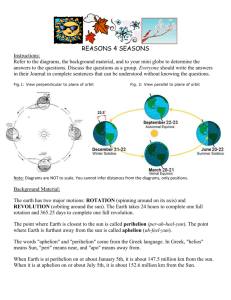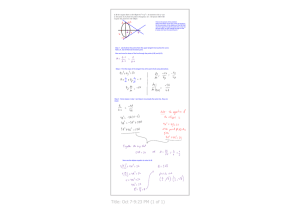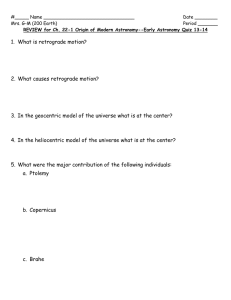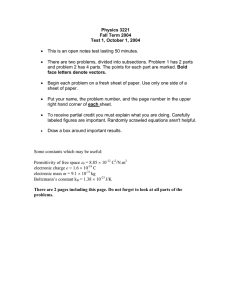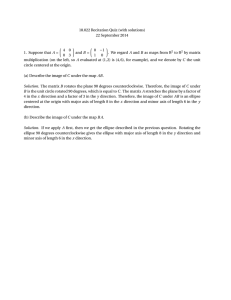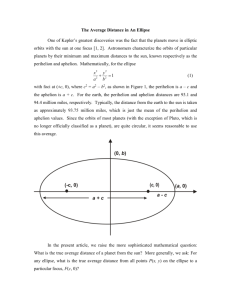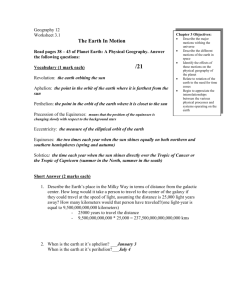Derivation of Kepler’s Third Law and the Energy Equation for an... C.E. Mungan, Fall 2009
advertisement
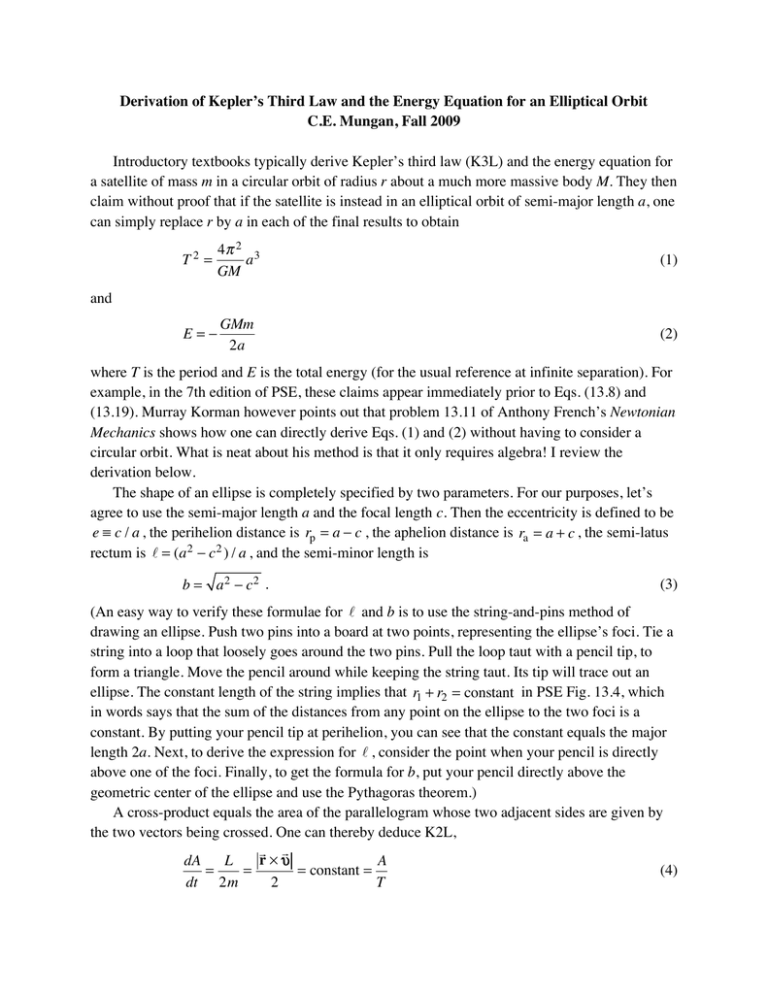
Derivation of Kepler’s Third Law and the Energy Equation for an Elliptical Orbit C.E. Mungan, Fall 2009 Introductory textbooks typically derive Kepler’s third law (K3L) and the energy equation for a satellite of mass m in a circular orbit of radius r about a much more massive body M. They then claim without proof that if the satellite is instead in an elliptical orbit of semi-major length a, one can simply replace r by a in each of the final results to obtain T2 = 4π 2 3 a GM (1) E=− GMm 2a (2) and where T is the period and E is the total energy (for the usual reference at infinite separation). For example, in the 7th edition of PSE, these claims appear immediately prior to Eqs. (13.8) and (13.19). Murray Korman however points out that problem 13.11 of Anthony French’s Newtonian Mechanics shows how one can directly derive Eqs. (1) and (2) without having to consider a circular orbit. What is neat about his method is that it only requires algebra! I review the derivation below. The shape of an ellipse is completely specified by two parameters. For our purposes, let’s agree to use the semi-major length a and the focal length c. Then the eccentricity is defined to be e ≡ c / a , the perihelion distance is rp = a − c , the aphelion distance is ra = a + c , the semi-latus rectum is = (a 2 − c 2 ) / a , and the semi-minor length is b = a2 − c2 . (3) (An easy way to verify these formulae for and b is to use the string-and-pins method of drawing an ellipse. Push two pins into a board at two points, representing the ellipse’s foci. Tie a string into a loop that loosely goes around the two pins. Pull the loop taut with a pencil tip, to form a triangle. Move the pencil around while keeping the string taut. Its tip will trace out an ellipse. The constant length of the string implies that r1 + r2 = constant in PSE Fig. 13.4, which in words says that the sum of the distances from any point on the ellipse to the two foci is a constant. By putting your pencil tip at perihelion, you can see that the constant equals the major length 2a. Next, to derive the expression for , consider the point when your pencil is directly above one of the foci. Finally, to get the formula for b, put your pencil directly above the geometric center of the ellipse and use the Pythagoras theorem.) A cross-product equals the area of the parallelogram whose two adjacent sides are given by the two vectors being crossed. One can thereby deduce K2L, r×υ dA L A = = = constant = (4) dt 2m 2 T as in PSE Eq. (13.7). Here L is the magnitude of the satellite’s angular momentum using a coordinate system whose origin is centered on the heavy mass M. The position and velocity of the satellite are r and υ , respectively. The area of an ellipse is A = π ab = π a a 2 − c 2 (5) using Eq. (3). (A quick way to prove the first equality is to note that A equals 4 times the area of a ∫0 y dx . Now transform to the dimensionless coordinates 1 X ≡ x / a and Y ≡ y / b , so that I becomes ab ∫ Y dX . But the rectangular equation of the ellipse 0 the ellipse in the first quadrant, I ≡ in these new coordinates is X 2 + Y 2 = 1 , which is a unit circle of area π.) Finally, note that at perihelion and aphelion, vectors r and υ are perpendicular to each other, so that Eq. (4) becomes (a + c)υ a π a a 2 − c 2 (a − c)υ p = = 2 T 2 (6) and thus the relation between the satellite’s speed at aphelion and perihelion is ⎛ a − c⎞ υa = υp ⎜ . ⎝ a + c ⎟⎠ (7) Finally, the energy of the satellite is the sum of its kinetic and potential energies, which is a constant and can be written down at perihelion and aphelion as 1 GMm 1 GMm . mυ a2 − = E = mυ p2 − 2 a+c 2 a−c (8) Substitute Eq. (7) into the first term and rearrange to obtain υ p2 = GM ⎛ a + c ⎞ ⎜ ⎟ a ⎝ a − c⎠ (9) which neatly expresses the perihelion speed in terms of known parameters. Substituting it into the right-hand sides of Eqs. (6) and (8) then gives Eqs. (1) and (2) after some algebra. The preceding derivation is a nice illustration of the fact that properties of elliptical orbits can be deduced in general from the two constants of the motion, namely angular momentum and mechanical energy. In particular, Eq. (2) indicates that if one fixes E, the major length 2a of the satellite’s orbit is determined. However the eccentricity varies with L; only for the special case when E and L are related by E = −L2 / 2ma 2 is the orbit circular. (This explains why bound orbits are not always circular!) Notice that Eq. (9) was key to the problem. So it’s useful to consider an alternative way of deducing it, albeit using calculus. At perihelion, the satellite has zero tangential acceleration and thus the acceleration is purely centripetal, GM = κυ p2 2 rp (10) where the curvature κ equals the reciprocal of the radius of curvature and can be calculated using the standard formula, κ= y′′ . (1 + y′ 2 )3/2 (11) To avoid an infinite slope at perihelion, let’s rotate the coordinate system 90° and consider the negative branch of the elliptical curve, 2 2 x2 ⎛ x⎞ ⎛ y⎞ ⎜⎝ ⎟⎠ + ⎜⎝ ⎟⎠ = 1 ⇒ y = −a 1 − 2 . b a b (12) From a diagram of an ellipse, it is clear that the slope y′ is zero at perihelion (where x = 0 ) and thus κ = y′′(0) . Evaluating it from Eq. (12), one gets the simple result that the radius of curvature equals the semi-latus rectum. Substituting κ = a / (a 2 − c 2 ) and rp = a − c into Eq. (10) transforms it into Eq. (9).

